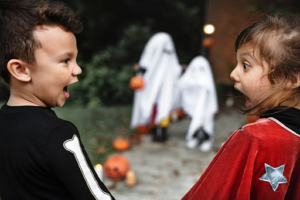
Spooky season is among us. For some children, this time of the year brings warm cozy feelings, excitement about costumes and candy, and eagerness about decorating your house full of ghouls and ghosts. For others, this season may bring up fear and anxiety about the festive yet scary decorations they see around the neighborhood. If your child has been expressing more anxiety surrounding the topic of Halloween, you can create a plan to help them feel more in control and calm when it comes to seeing these unexpected decorations. Below are some tips and tricks (unfortunately not treats!) to use while making a “Halloween Plan” or “Scary Decoration Plan.”
- Choose a calming strategy
My favorite calming strategy to add to plans that you will need to access outside of the house is taking deep breaths. Deep breaths increase the amount of oxygen being supplied to your brain which in turn stimulates the parasympathetic nervous system. This results in your body and brain feeling more calm. The added bonus of deep breaths is that all you need in order to access them is your own body! This makes them a great tool for unexpected decorations that may pop up around this time of year.
Another great tool for unexpected decorations can be co-regulation. Providing deep pressure through hugs or body squeezes can assist your kid in regulating their body when self-regulation strategies don’t seem helpful or if your child is too young to self-regulate.
If you know you are going somewhere that will be decorated and you have time to plan ahead, you can help your child choose an easily accessible comfort item. This can be a stuffed animal, a favorite fidget, a blanket of choice, etc. Anything that regularly brings your child a sense of serenity will do the trick.
- Develop a mantra your child can repeat
Mantras are great because when feeling fearful of decorations, your child might be cycling through worry-filled thoughts like, “Those things are so scary,” “I want to run and hide,” and “I don’t feel safe!” The mantra can be used to interject those worries and cycle through a more comforting thought.
These mantras can include:
Positive self-talk – “I am brave, I am strong, I can do this,” “I can do hard things!”
Rationalizations – “These decorations are pretend,” “Those decorations are fake, they can’t get me!”
- Use mental imagery
If your time and environment allows for it, you can encourage your child to engage in mental imagery so they can imagine something that makes them feel happy. If you create a written or typed plan, your child can even choose actual pictures they want added to it that make them feel calm.
Extra Tips:
- Give your child TONS of control over developing this plan. Let them pick specific strategies, mantras, mental images, etc. If you write or type the plan to make a visual aid let them choose the colors of the font and what pictures go on it!
- Introduce the plan and expose your child to decorations in small steps that help them feel most comfortable. For example, you can look at pictures of individual decorations, then pictures of houses fully decorated, then encourage them to decorate your own house, and then maybe you can walk to a neighbor’s house to see their decorations!
- Practice the plan when your child is in a calm and regulated state. Your family can even role-play using the plan. The more they practice it when relaxed, the more comfortable their body will be with using it when worried!
- Model yourself using the plan. The more your child sees you use the plan, the more they will be inclined to do the same!
- If you’re worried about decorated houses playing scary music, or having loud sound effects you can always encourage your child to try noise canceling headphones.
- Don’t force it! If your child isn’t at the point where they’ll successfully be able to approach scary decorations then that’s totally okay! You don’t want to further increase their resistance towards the holiday by desensitizing them too quickly or too soon.
- If you participate in Halloween festivities, in addition to creating a calming plan you can also increase your child’s excitement about the holiday with fun activities. These could include things like painting pumpkins, coloring pictures of silly skeletons or black cats, pretending to be a ghost with their favorite blanket, and even asking for your child’s input in picking out what candy the household will pass out on Halloween.
- Most importantly, make sure to provide tons of praise for your child for every interaction they have with Halloween related activities to increase their positive correlation with the holiday and their self-esteem!
Melissa Svec, MSW, LSW
Resources:
https://www.stress.org/take-a-deep-breath
https://childmind.org/article/taking-halloween-by-the-horns/
Image from: https://www.rawpixel.com/image/468554/premium-photo-image-adorable-autumn-boy
